This post may contain affiliate links. Please read our disclosure policy.
Learn how to peel and cut a pineapple using a knife or using the “peeling pineapple” hack (for a pull-apart pineapple). All you need is a sharp knife and a ripe pineapple, and away you go!
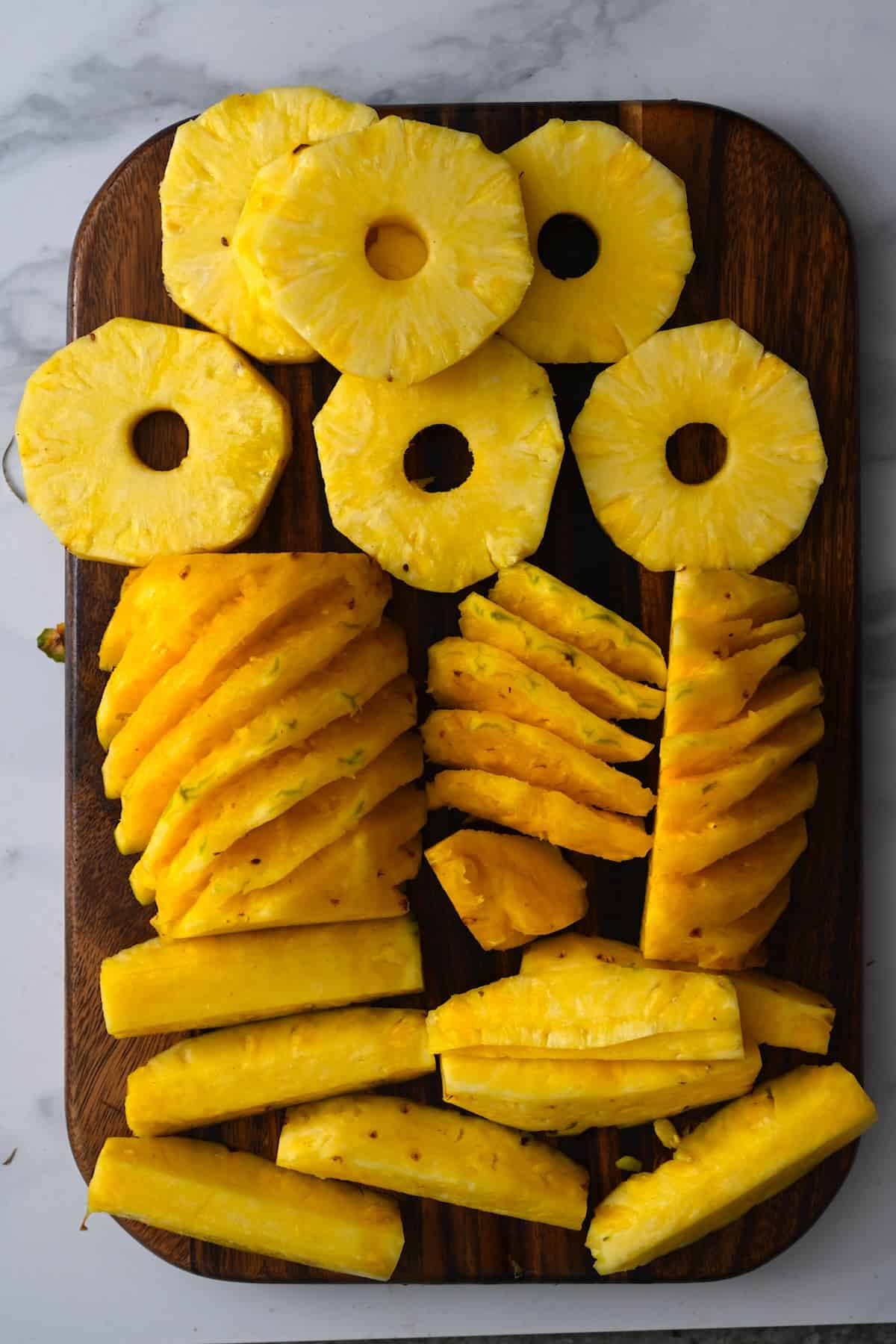
I love pineapple, whether it’s eating it as a snack or adding it to juices, smoothies, cocktails (like yummy Pina Colada!), salads (like this cucumber pineapple salad or a fruit salad), salsas, marinades, desserts, and more – there’s an endless list of ways to enjoy this sweet, tropical fruit. However, I recently found out that many (or at least a lot more than I expected) of my Instagram followers avoid buying whole pineapples simply because they seem intimidating to prepare.
Honestly, I don’t blame them. However, it’s surprisingly simple to learn an easy way to cut a pineapple that suits your needs (rings, wedges, chunks, etc.). Plus, following a TikTok viral pineapple peeling “hack,” there is now even a way to peel and separate pineapple without the need for chopping!
Within this post, I’ll be taking you through how to choose a ripe pineapple and how to peel, chop and core a pineapple easily. I’ve included methods using a knife or other tools as well as using the method for a “pull-apart pineapple.”
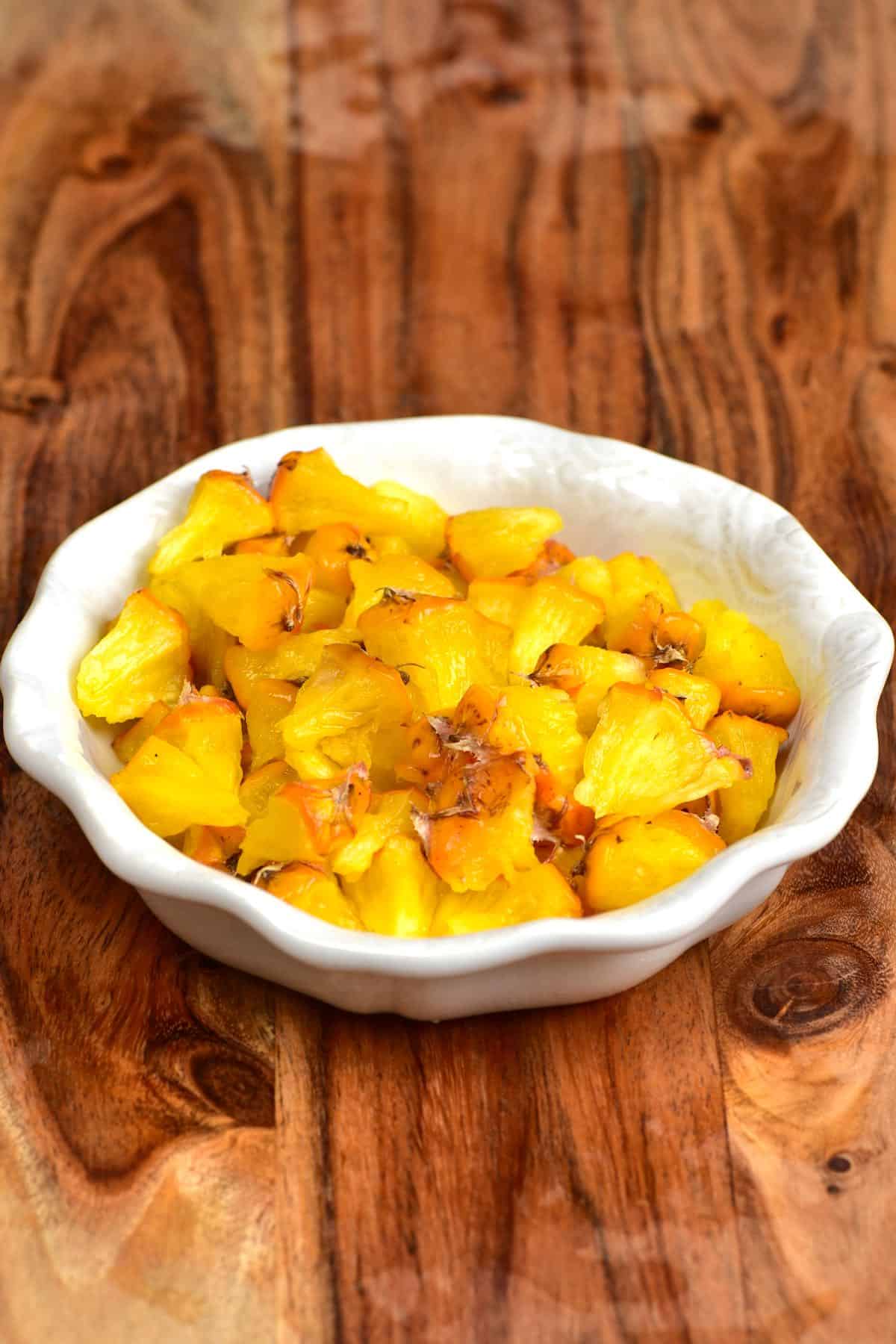
As a bonus, I’ve tried to share this method as a way to cut a pineapple without waste. So I’ve included several ways to use the peel and core. I also have a separate post in the works on how to plant the top of the pineapple.
But for now, let’s jump right in and take away your pineapple blues!
Want to save this recipe?
Table of Contents
- How to tell if a pineapple is ripe
- How to peel and chop pineapple (traditional method)
- How to peel a pineapple (pull-apart pineapple)
- Storage instructions
- What to do with the pineapple skin and core?
- A few notes on consuming pineapple
- More easy tutorials
- How To Cut A Pineapple (+ Peeling Pineapple Hack) Recipe
How to tell if a pineapple is ripe
There are a few tips/tricks that you can use to tell if a pineapple is ripe (which is important in general, but especially so when using the peeling “hack”). Here are just a few of the methods that I use.
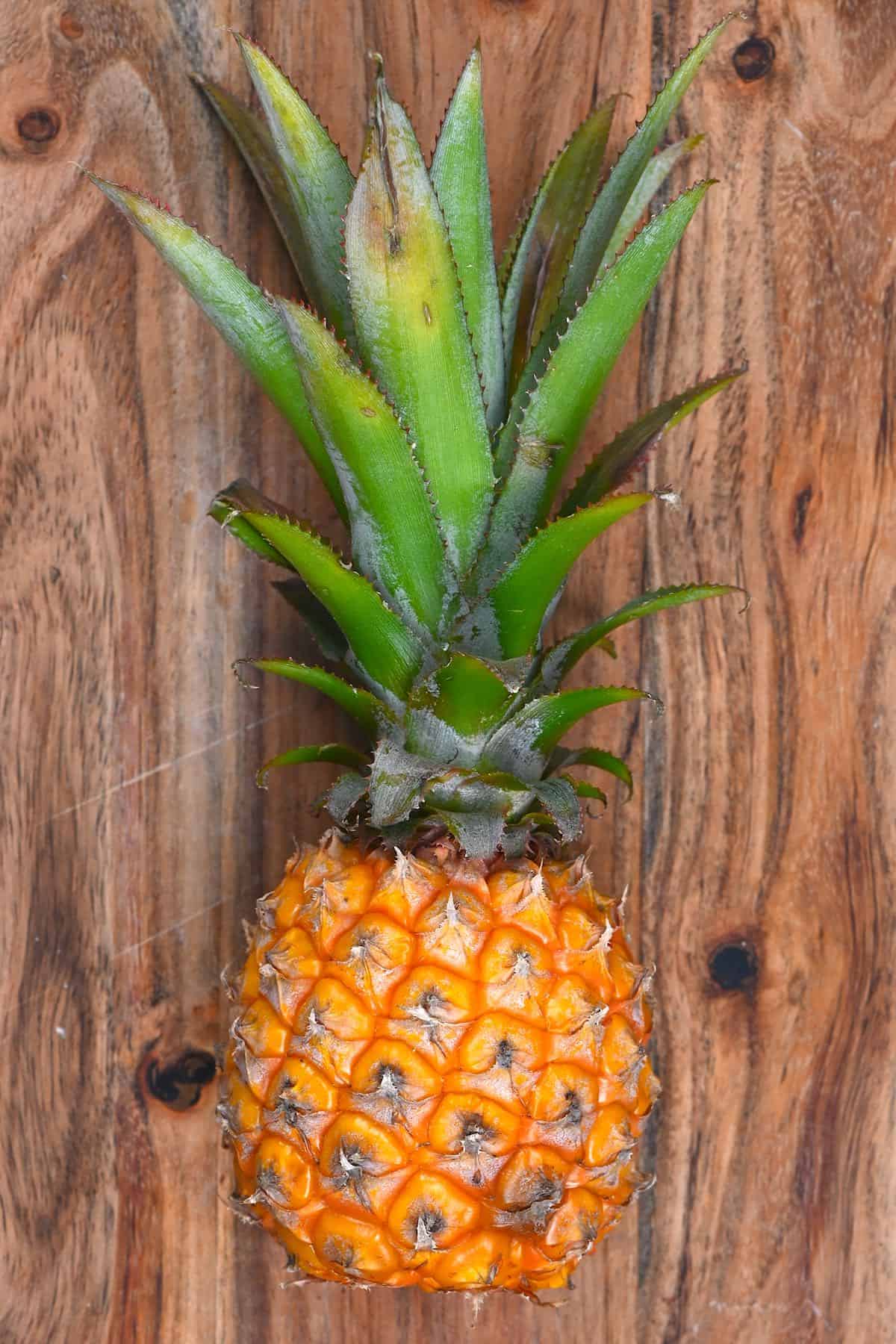
First things first, while pineapples are sold year-round, it’s important to know that peak season is March-July. So that’s the best time to take advantage of the peak quality and freshness!
1. By scent: like several types of fruit, scent can be important when selecting for ripeness. A ripe pineapple should smell sweet and fruity near the stem/”butt” end (not the spiky crown end). Avoid pineapples with little to no scent or even a slightly fermented/alcoholic smell.
2. By feel: another trick is gently squeezing the pineapple and seeing if it has a slight give. If it’s too firm, it’s not yet ripe enough.
3. By color: when choosing pineapples, you’ll notice they range from fairly green with a yellow tint to almost entirely amber/yellow. As a general rule, pineapples with a lot of green aren’t as ripe. However, it’s worth noting that some say that amber pineapples are overripe – but this isn’t always the case. I sometimes use ones that have no green at all, and yet they aren’t overripe.
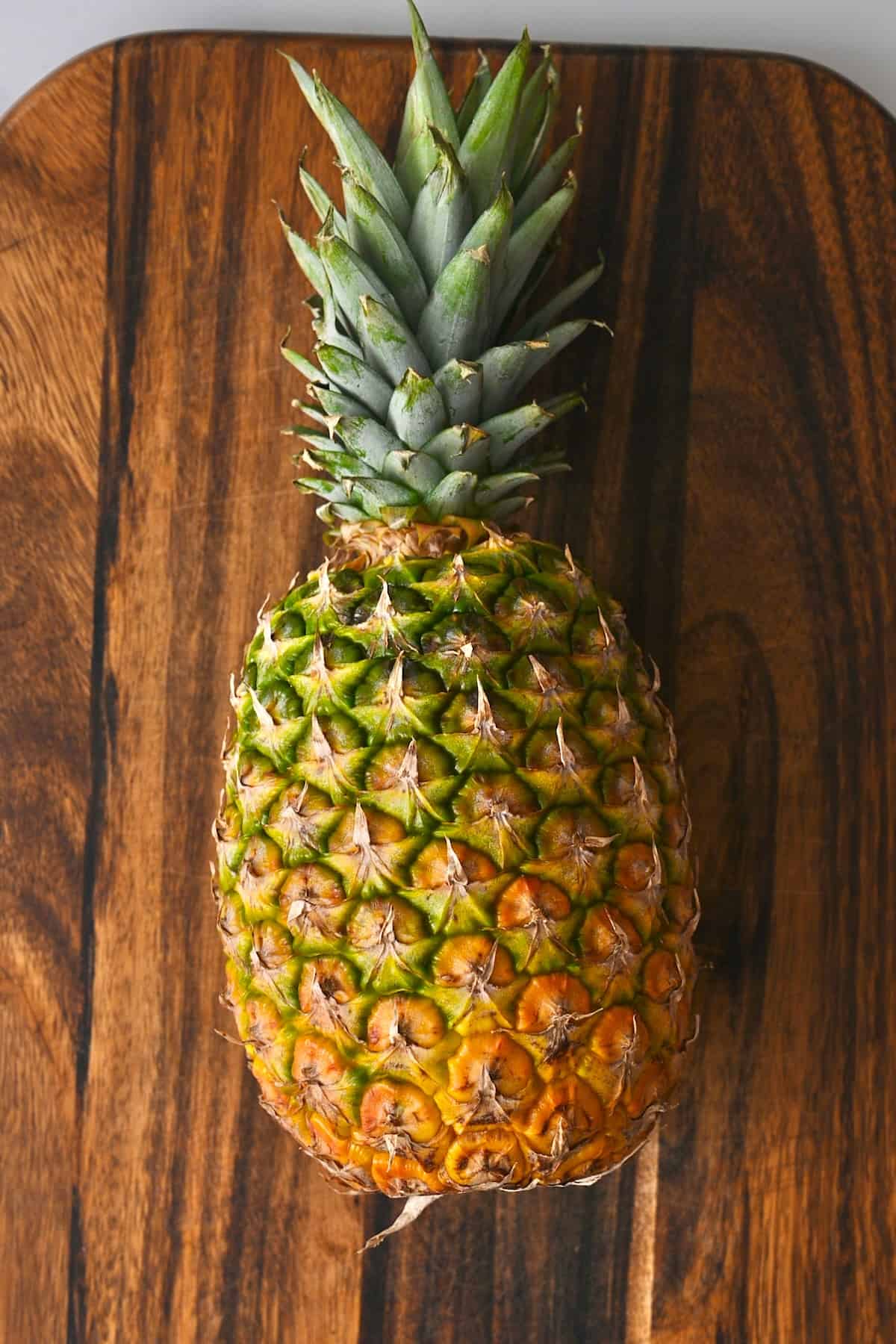
Chef’s Note: you’ll likely notice that pineapples are always more yellow at their stem end. This is where the fruit first absorbed nutrients and was “fed” with sugars. When the yellowing spreads further up the fruit, this usually makes for a sweeter overall pineapple.
Avoid pineapples that have unhealthy browning/wilting leaves, have begun turning brown, have become wrinkled, or have any signs of leaks/mold on them.
How to peel and chop pineapple (traditional method)
If you’d prefer to peel, chop, and (optionally) core your pineapple the traditional way, no problem.
Step 1: How to Peel a Pineapple
First, place the pineapple sideways on a cutting board and slice off the top green crown and bottom.
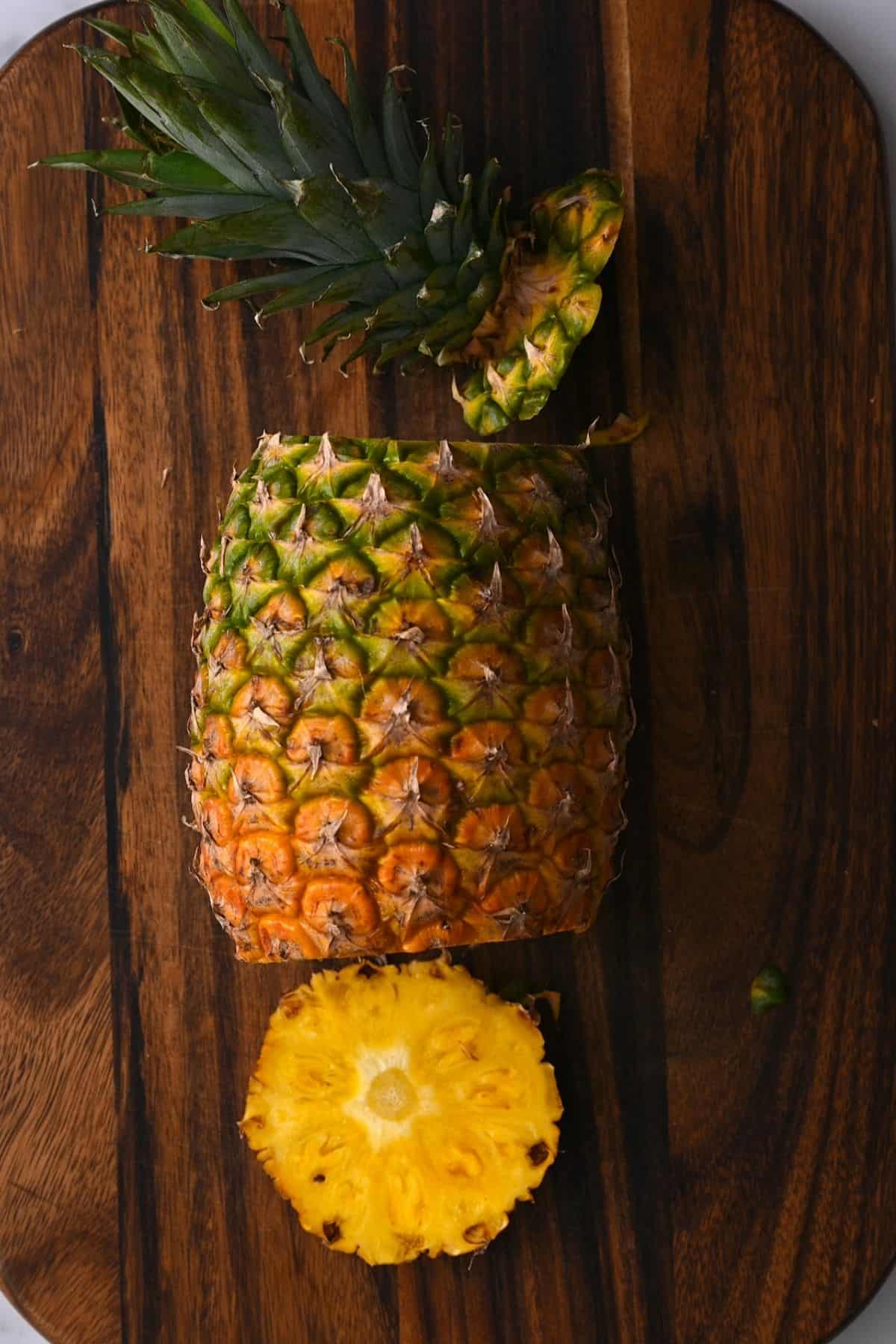
Then, stand the pineapple upright and use a sharp chef’s knife to slice away strips of the outer peel/rind.
There are two ways to do this. You can either make thin slices (you’ll then need to go back and slice away the “eyes” afterward). OR thicker slices; that way remove more flesh but will remove the eyes too.
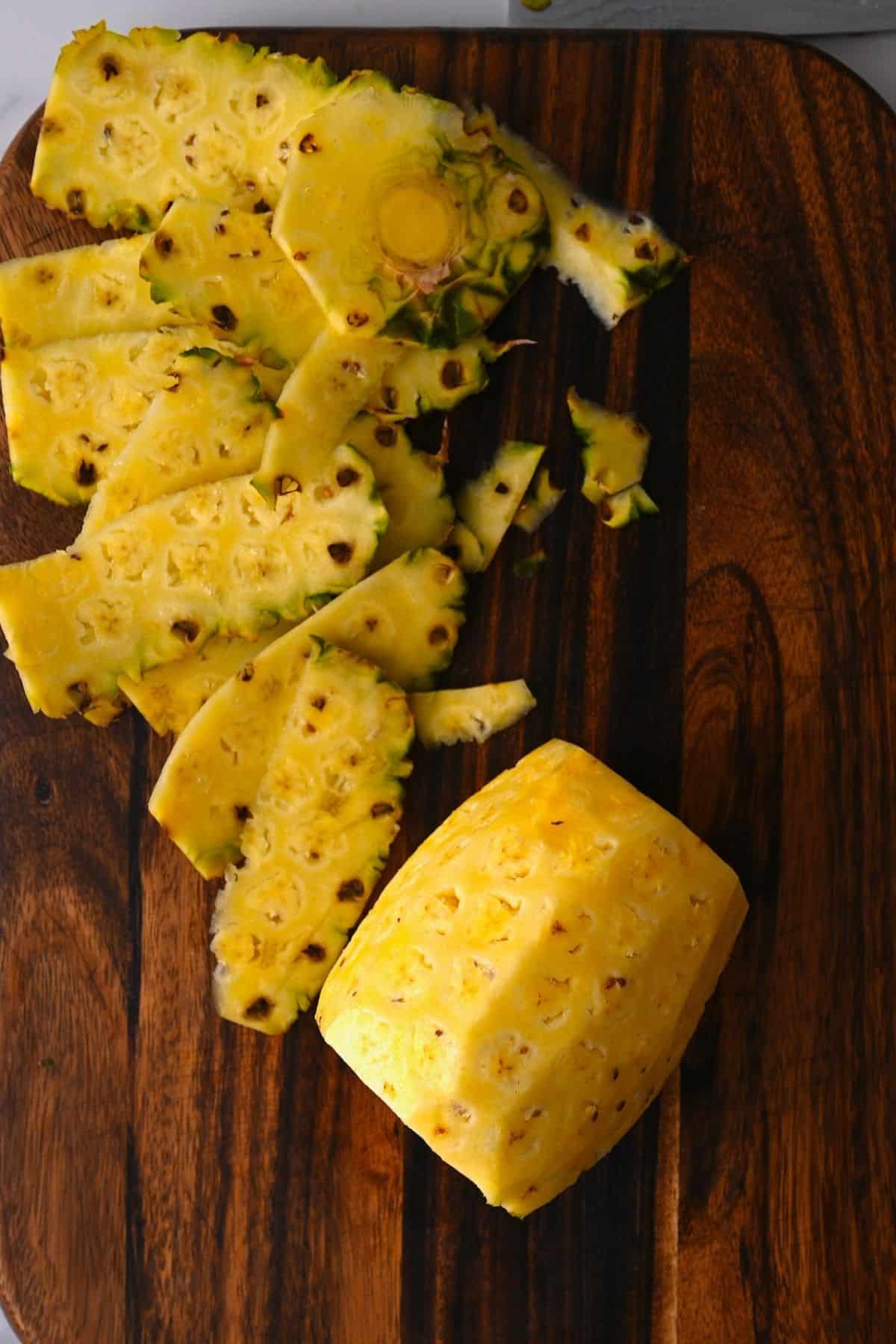
If you made the thin slices, you’ll need to remove the remaining “eyes”. You should be able to see that the “eyes” on the pineapple are in diagonal lines, making them easier to remove.
Simply line your knife up to one side of a row of 2-4 eyes and slice in a 45º angle, then move the knife to the other side of the eyes and repeat. That way, the two slices will meet in the middle (like a V-shaped trench), and you can pull away the fruity flesh with the eyes.
Alternatively, you can use a small paring knife to trim each eye. This is great for reducing waste but does take more time. Plus, you can use the removed eye flesh to make pineapple skin tea, too!
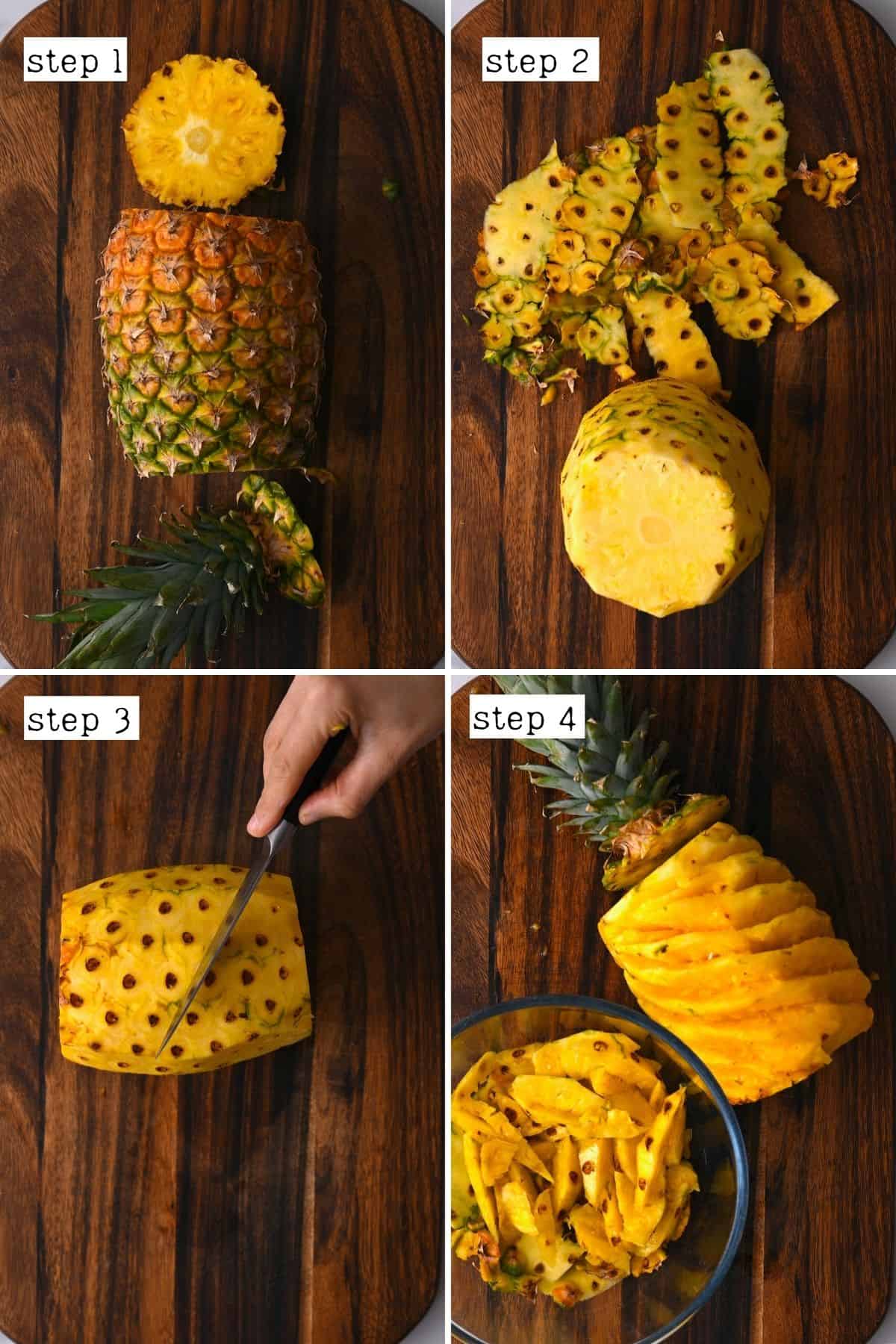
Step 2: How to Chop a Pineapple
There are several options you have to cut the pineapple (as well as core it) depending on if you want slices, wedges, tiny pieces, etc.
Wedges/spears: cut the pineapple into quarters lengthwise and then simply slice the core away (which is the very inner part of each slice and will be visible). You can then slice the pineapple lengthwise to make thinner spears.
You can do this step with or without the pineapple peel still attached.
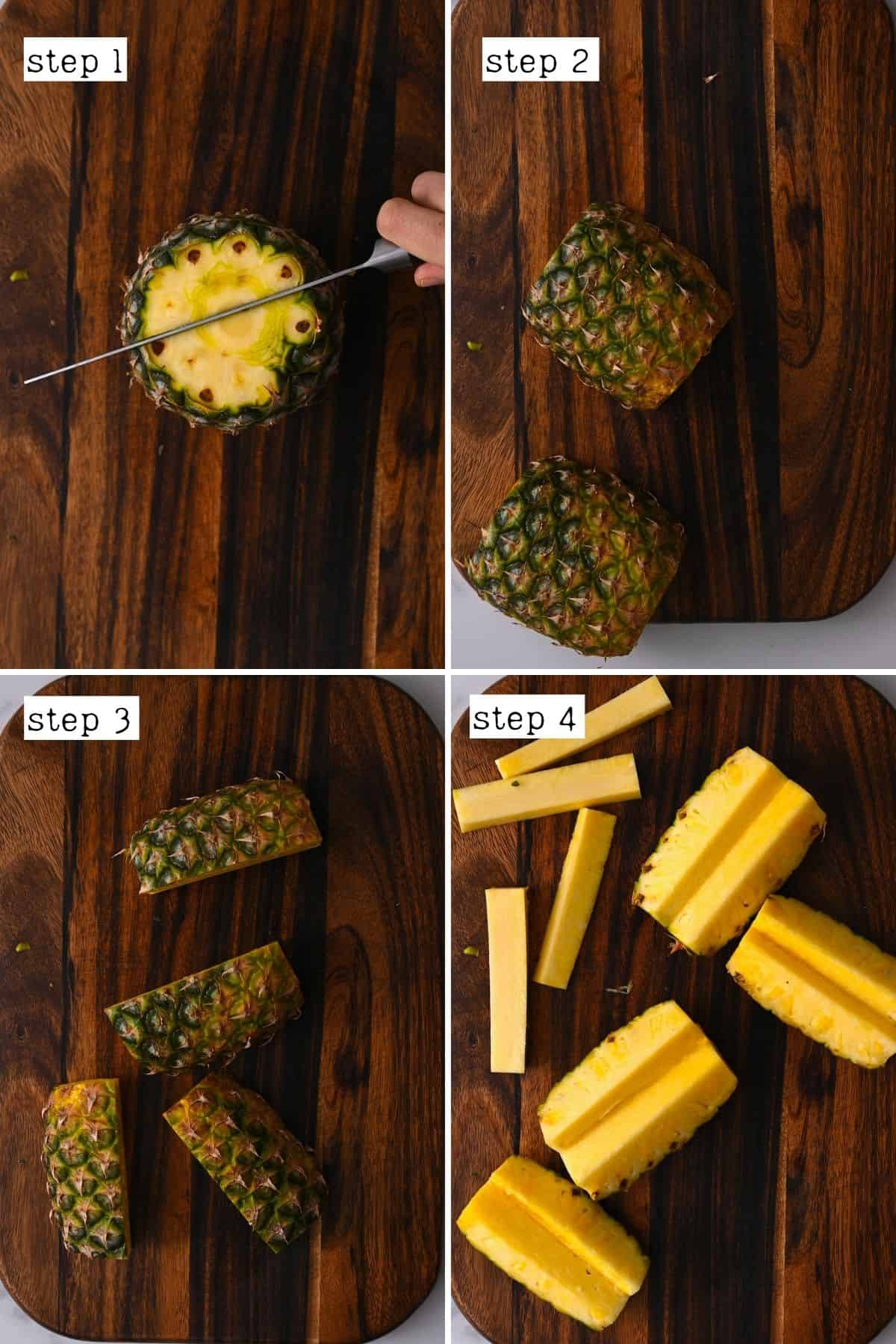
Chunks/cubes: after following the above, make slices along the length of each quarter/spear as thin or thick as you’d like.
Rings: lay the pineapple on its side and carefully slice the pineapple flesh into rings as thin/thick as you’d like. To core the pineapple rings, I find it easiest to use a small cookie cutter or similar tool (like an icing tip) to simply press into each piece and remove it.
Alternatively, you can use a small, sharp knife to slice away the core from each piece, but this will take longer and won’t look as clean-cut. The easiest way to do this is to make 5-6 individual slices around the core and then pull it away.
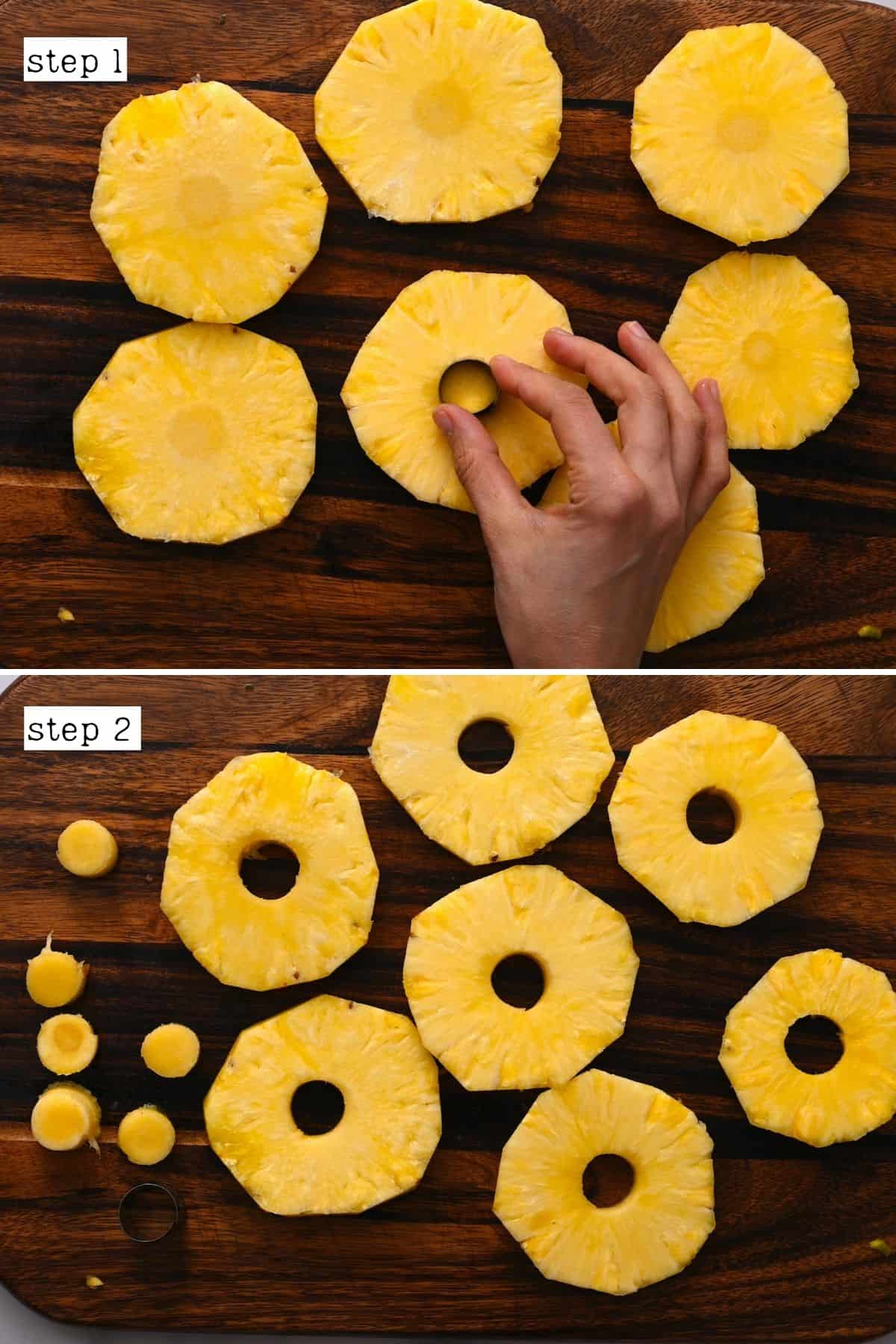
Bonus Method: Using a Pineapple Corer
This tool does two jobs in one. First, it removes the core. However, it also slices through the pineapple, so you don’t have to peel/chop the flesh at all.
Simply chop off the top and optionally the bottom of the fruit, stand it upright on your chopping board, place the center of the corer over the pineapple core, and twist it to the bottom of the pineapple. You can then lift and pull it up and release the fruit from the gadget.
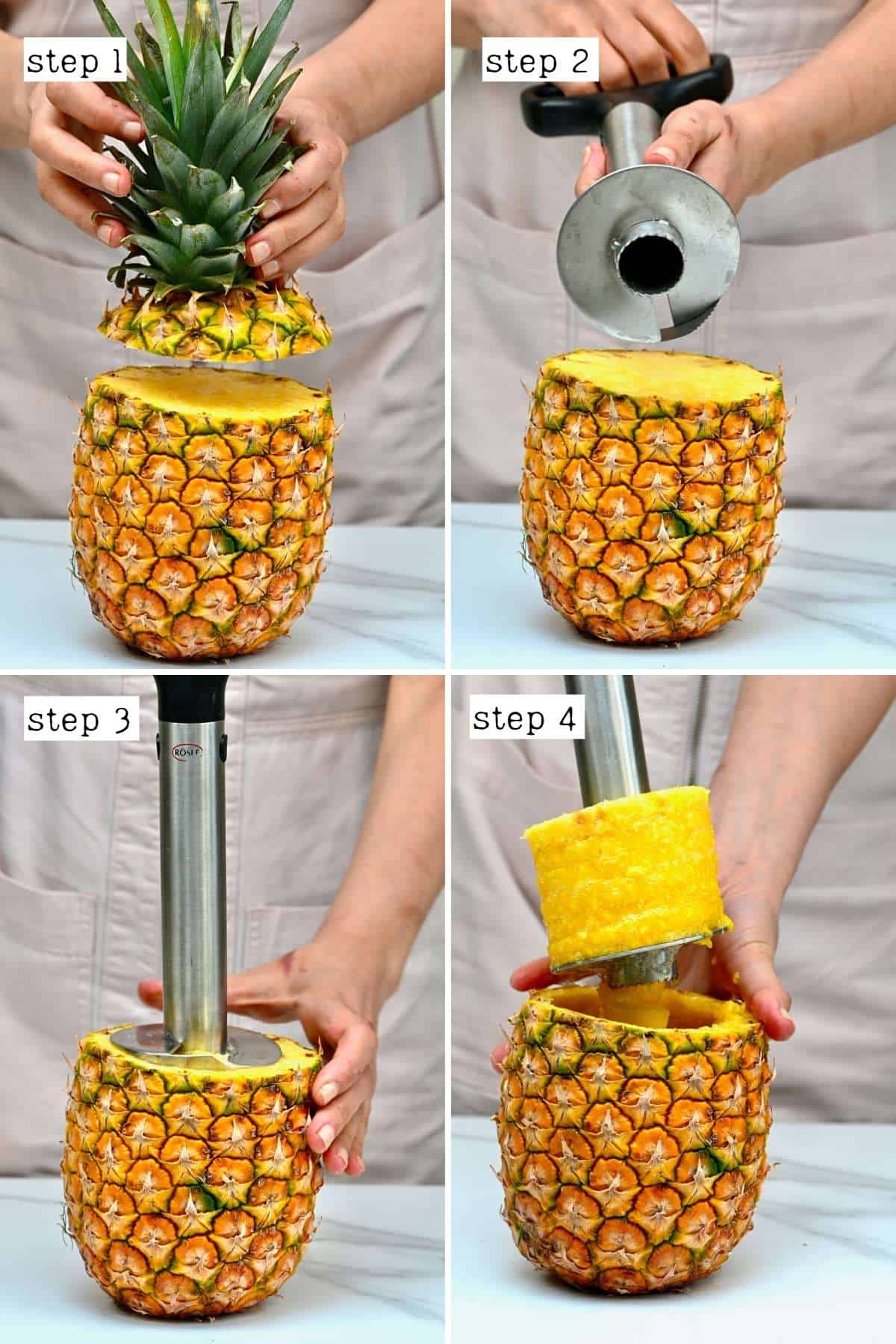
How to peel a pineapple (pull-apart pineapple)
You may not know this, but pineapples are made up of multiple fruits. While it comes to us in a pretty individual “package,” pineapples are considered a berry – or rather lots of individual berries that have joined together to create a single larger fruit. Thus, each “eye” of the pineapple is an individual fruit. These fruits then connect to the inner stem, holding them together.
This pineapple peeling hack uses that knowledge to help you “peel” a pineapple without needing to slice it!
Top Tip For Using This Pineapple Hack
For this particular pull apart pineapple hack, it’s best to use a very ripe pineapple (but not overripe). That way, it’s easier to manually separate/pull apart each “eye,” which is an individual fruit. And if you’re going to be peeling a pineapple, you want it to be simple!
However, if you remove the pineapple crown, you’re able to manually push on each “eye” (fruit) to loosen it from the surrounding fruit and then peel the pineapple of each fruit, one by one.
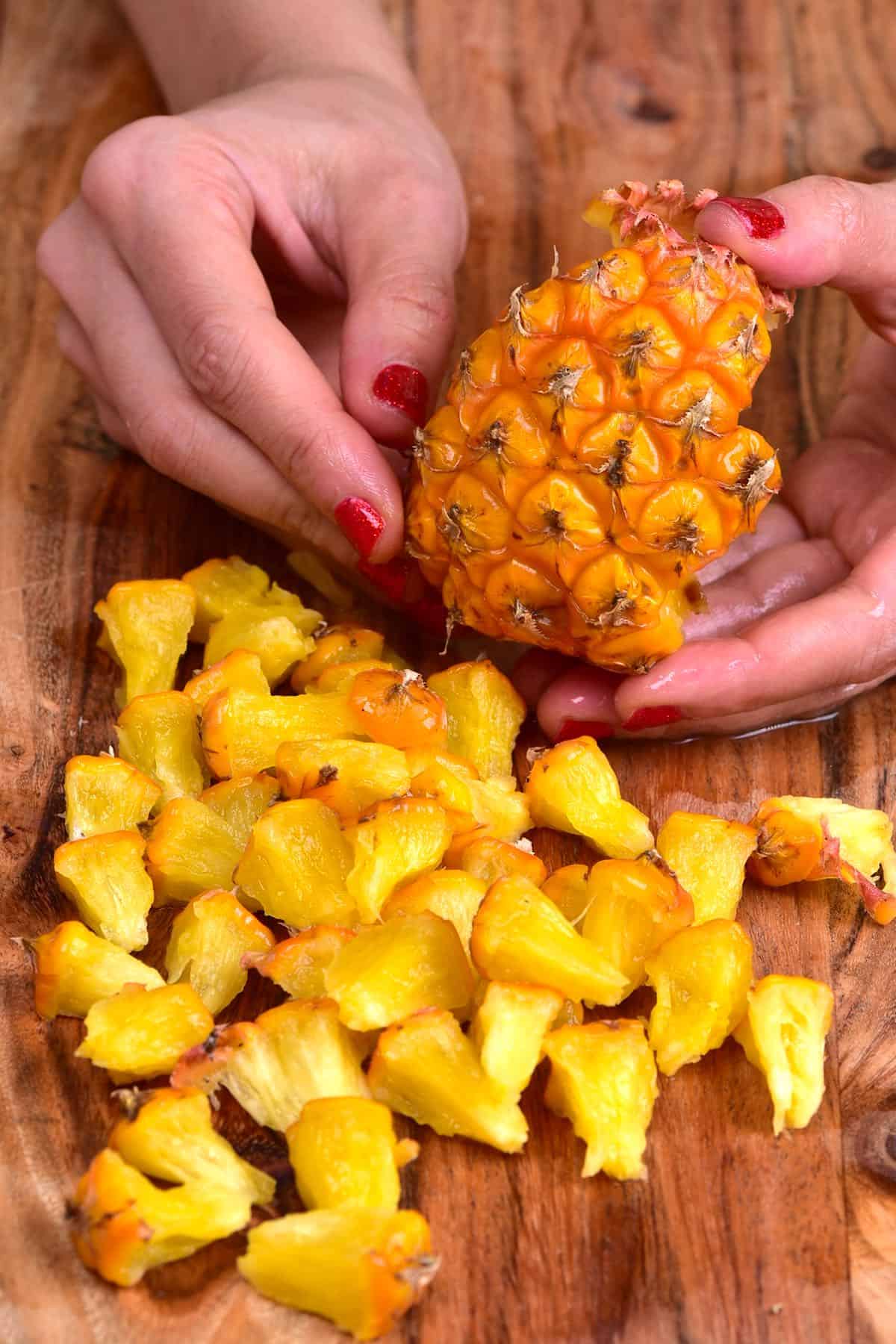
It’s not always foolproof, and it does take choosing the “right” pineapple – but when it works, it’s so worth it!
The Step-By-Step
Though this method is “virtually” knife free, you will need one to get the process started. I like to use a fairly small pairing knife.
Step 1: Roll the Rineapple
Roll the pineapple on your kitchen counter. Be firm, but not too firm as you want to break up the various fruits inside to make them easier to pull apart.
I’m not sure how helpful it is to do this before removing the crown vs. before and after or just after. So, for the sake of making things easiest for myself, I do both.
Step 2: Remove the Pineapple Top (Crown)
You can do this by grabbing it at the base and pulling, though sometimes this can be tricky. Alternatively, use your small knife and, rather than simply chopping around the top, press it in-between the eyes going all the way around the pineapple, and it should then be easy to pull apart.
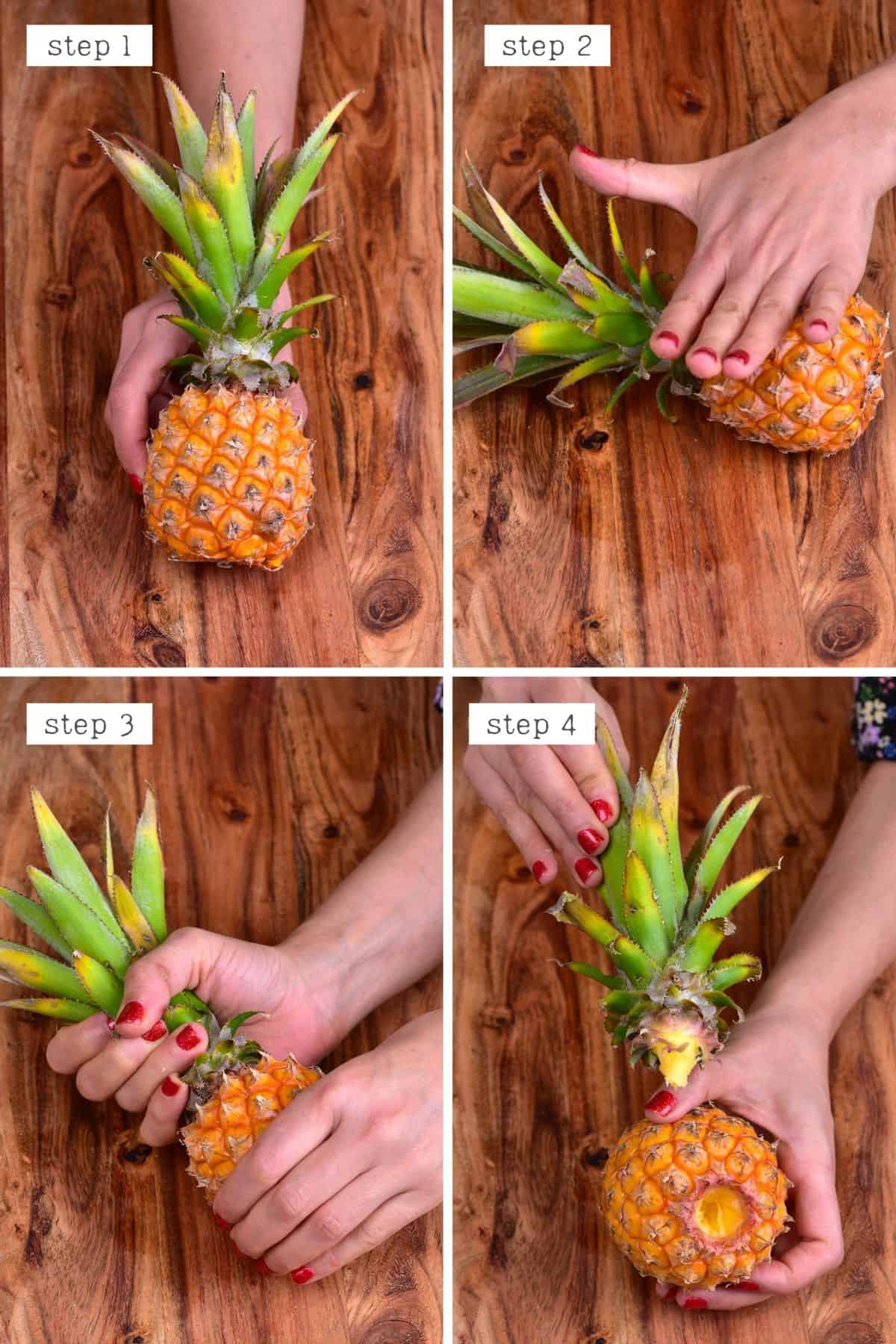
You could also chop the entire top off, but then you’ll have to deal with removing individual fruits (the eyes) that are cut in half, to begin with, which could make things trickier.
Step 3: Pull it Apart
You can optionally roll the pineapple over the surface again to loosen the fruit. Then, it’s time to pull it apart. Rather than simply pulling the pieces, I’ve found it easy to push lightly at the base of each eye. This separates it from its surrounding pieces to then pull and remove.
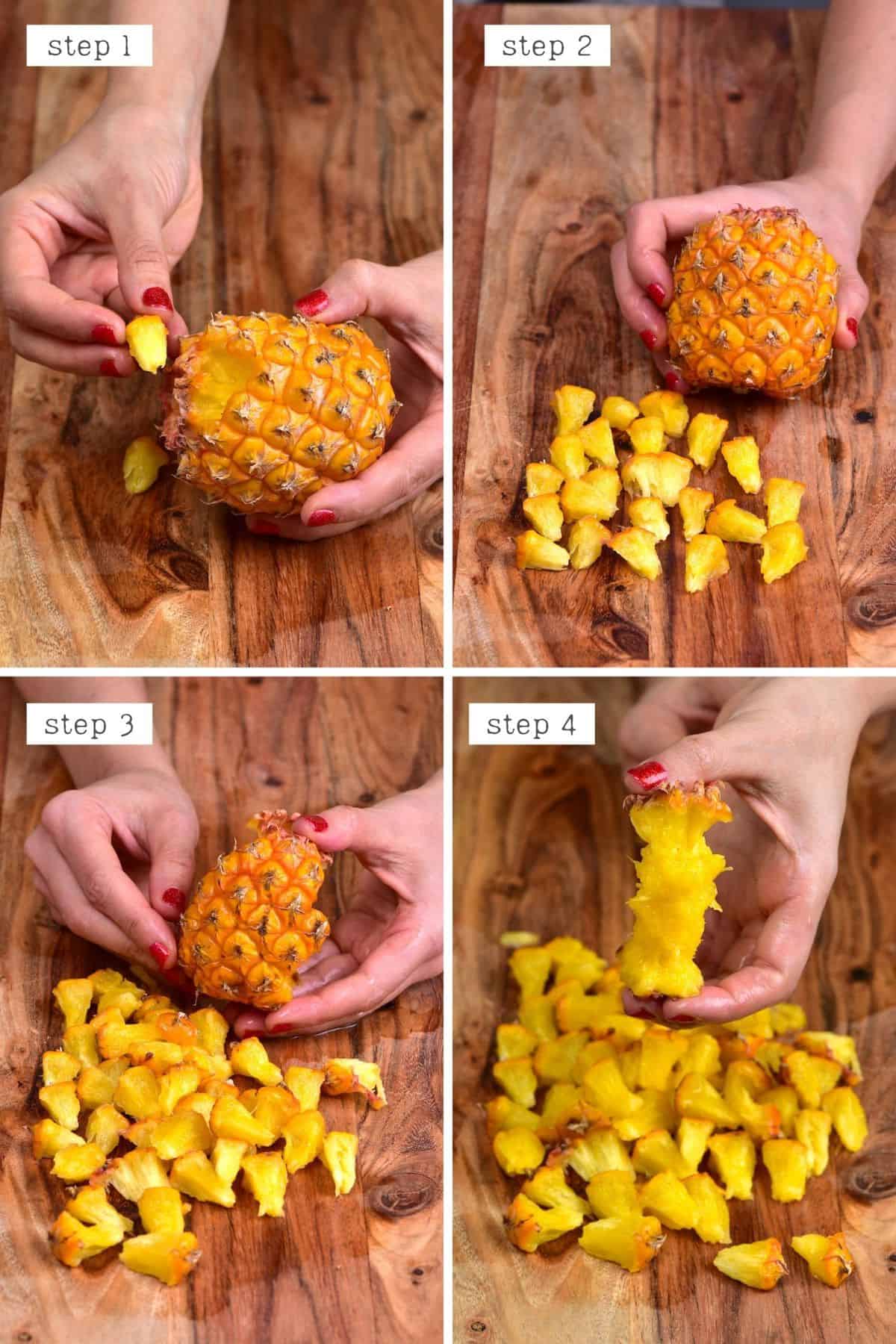
Repeat this step until you’ve removed as much as you want or have done so with the entire pineapple and enjoy immediately or store for later.
Storage instructions
Fridge: store any open fresh pineapple/cut pineapple chunks in an airtight container (or reusable Ziplock bag) in the refrigerator and eat within 2-3 days. Some leave theirs for up to 5 days, but I find that it can become a stomach irritant after 2 days (3 at most).
Even in an airtight container, it may start turning brown. To avoid this, you can squeeze a little orange/lemon juice over the pieces before storing them. You can also store the pieces in the juice for 3-4 days.
To Freeze: semi-freeze the pieces until solid in a single layer on a large tray before moving the pieces into an airtight bag/container for storing. Eat within 6-7 months.
What about at room temperature? A whole pineapple that’s ripe will last about 3 days at room temperature.
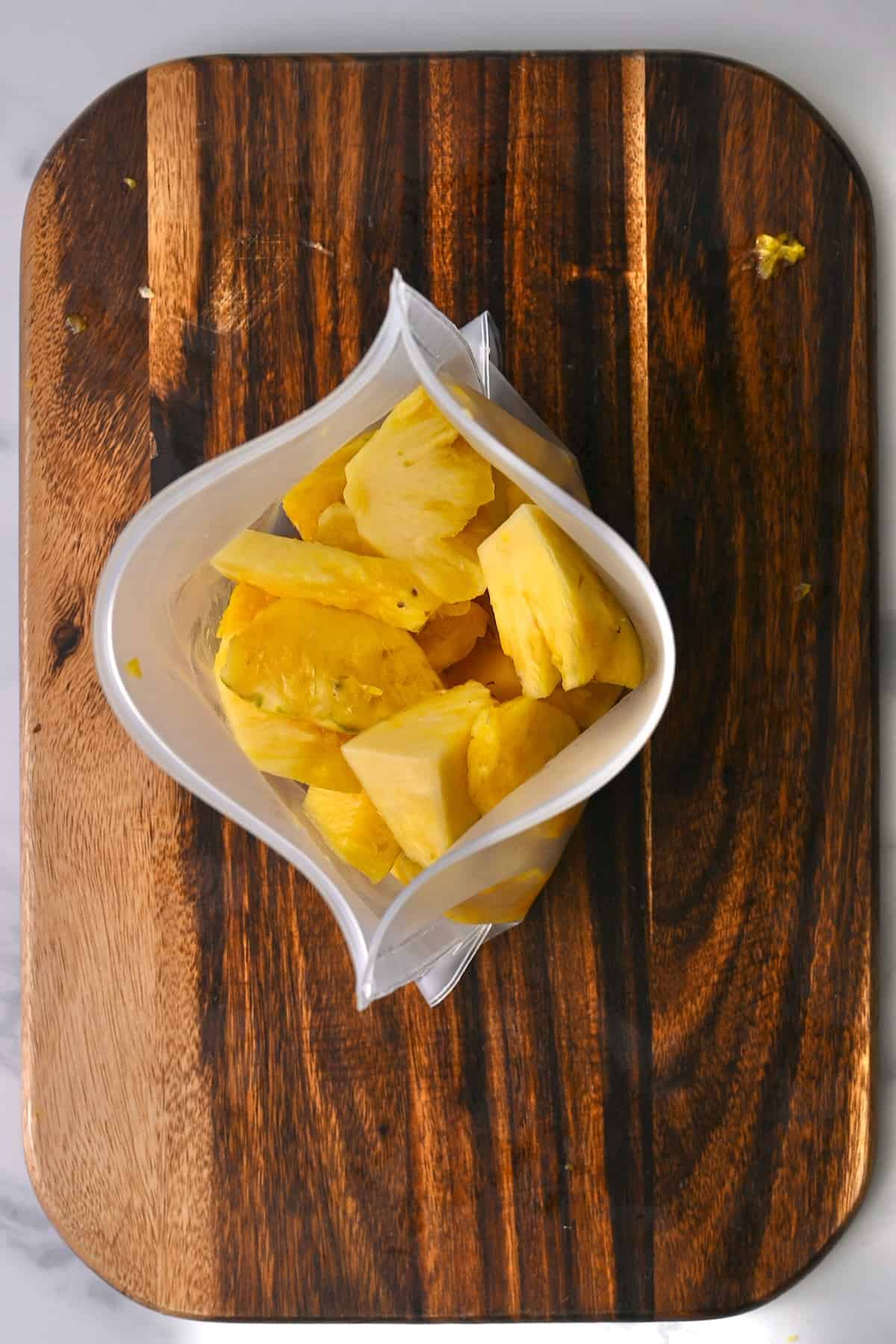
What to do with the pineapple skin and core?
You can make pineapple skin tea with any leftover peel. It combines the power of pineapple peel, turmeric, ginger, honey, and more for a sweet, flavorful anti-inflammatory tea! Alternatively, you can make a delicious fermented tepache drink.
If you’re left with core, there are several ways to enjoy it, including:
- Add to smoothies or pass through a juicer.
- Add to soups.
- Thinly slice and dehydrate into pineapple “chips”.
- Shred it into salads.
If you briefly boil the pineapple core, this will make it easier to slice and mash into various meals too (as well as make it more easily digestible). It could then be used to make a sorbet or even for topping homemade yogurt/granola bowls, etc.
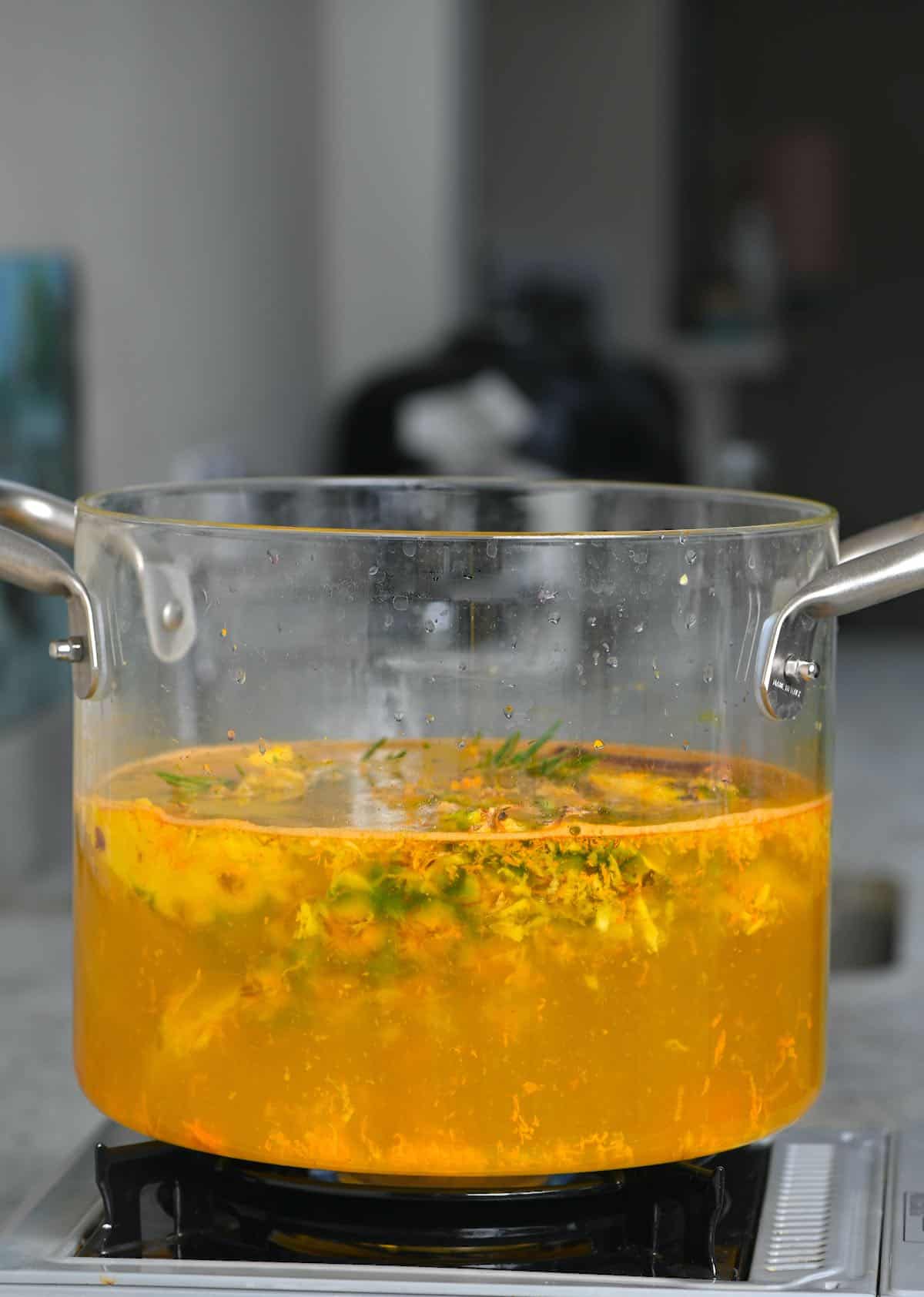
A few notes on consuming pineapple
- Pineapples are highly acidic, so those who struggle with acid reflux may do well to avoid eating too much if any. To reduce the pineapple’s acidity, you can pair it with yogurt or another creamy dairy (or so I’ve heard), as it helps to neutralize the pH.
- Furthermore, pineapple contains an enzyme called bromelain, which actually breaks down proteins and can cause a mouth-burning feeling – as it’s starting to break down the mouth lining. Luckily our stomachs neutralize it by breaking down the bromelain, but it can make our mouths hurt. To avoid this, you can soak pineapple in salt water overnight (then rinse well, so it doesn’t taste salty). Alternatively, cooking pineapple also breaks down the enzyme.
More easy tutorials
If you try this peeling pineapple hack, then let me know your thoughts and questions in the comments. I’d also really appreciate a recipe rating and would love to see your recreations – just tag @AlphaFoodie.
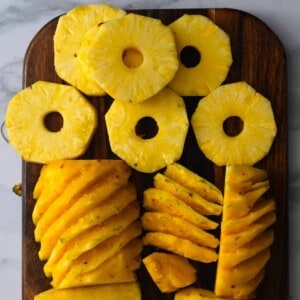
How To Cut A Pineapple (+ Peeling Pineapple Hack)
Equipment
- Pineapple Corer optional
Ingredients
- 1 pineapple
Instructions
Step 1: Peel the Pineapple
- Place the pineapple sideways on a cutting board and slice off the top green crown and bottom.
- Stand the pineapple upright and use a sharp chef's knife to slice away strips of the outer peel/rind. There are two ways to do this, you can either make thin slices (you'll then need to go back and slice away the "eyes" afterward) OR thicker slices, that way remove more flesh, but will remove the eyes too. (Refer to the photos on the blog post.)If you made the thin slices, you'll then need to remove the remaining "eyes". You should be able to see that the "eyes" on the pineapple are in diagonal lines, which will make them easier to remove. Simply line your knife up to one side of a row of 2-4 eyes and slice in a 45-degree angle, then move the knife to the other side of the eyes and repeat. That way, the two slices will meet in the middle (like a V-shaped trench) and you can pull away the fruity flesh with the eyes. Alternatively, you can use a small paring knife to trim each individual eye. This is great for reducing waste but does take more time. Plus, the removed eye flesh can be used to make pineapple skin tea, too!
Step 2: Chop the Pineapple
- There are several options you have to cut the pineapple (as well as core it) depending on if you want slices, wedges, tiny pieces, etc. Wedges/spears: cut the pineapple into quarters lengthwise and then simply slice the core away (which is the very inner part of each slice and will be visible). You can then slice the pineapple lengthwise to make thinner spears.Chunks/cubes: after following the above, make slices along the length of each quarter/spear as thin or thick as you'd like. You can do this step with or without the pineapple peel still attached.Rings: lay the pineapple on its side and carefully slice the pineapple flesh into rings as thin/thick as you'd like. To core the pineapple rings, I find it easiest to use a small cookie cutter or similar tool (like an icing tip) to simply press into each piece and remove it. Alternatively, you can use a small, sharp knife to slice away the core from each piece, but this will take longer and won't look as clean-cut. The easiest way to do this is to make 5-6 individual slices around the core and then pull it away.
Method Using a Pineapple Corer
- This tool does two jobs in one. It removes the core. It also slices through the pineapple and removes it from the skin so you don’t have to peel/chop the flesh at all. Simply chop off the top and bottom of the fruit, stand it upright on your chopping board, place the center of the corer over the pineapple core, and twist it to the bottom of the pineapple. You can then lift and pull it up and release the fruit from the gadget.
The Pineapple Peeling "Hack"
- Roll the pineapple on your kitchen counter. Be firm, but not too firm as you want to break up the various fruits inside to make them easier to pull apart.I'm not sure how helpful it is to do this before removing the crown vs. before and after or just after. So, for the sake of making things easiest for myself, I do both.
- Remove the pineapple top (crown). You can do this by grabbing it at the base and pulling, though sometimes this can be tricky. Alternatively, use your small knife and, rather than simply chopping all the way around the top, press it in-between the eye going all the way around the pineapple, and it should then be easy to pull apart.You could also chop the entire top off, but then you'll have to deal with removing individual fruits (the eyes) that are cut in half, to begin with, which could make things trickier.
- You can optionally roll the pineapple over the surface again to loosen the fruit. Then, it's time to pull it apart. Rather than simply pulling on the individual pieces, I've found it easy to push lightly at the base of each eye to separate it from its surrounding pieces and then pull it to remove it.Repeat this step until you've removed as much as you want or have done so with the entire pineapple and enjoy immediately or store for later.
How To Store
- Store any open pineapple/pineapple chunks in an airtight container in the fridge and eat within 2-3 days. Some leave theirs for up to 5 days, but I find that it can become a stomach irritant after 2 days (3 at most).Note: even in an airtight container, it may start turning brown. To avoid this, you can squeeze a little orange/lemon juice over the pieces before storing them. You can also store the pieces in juice for 3-4 days.To freeze: semi-freeze the pieces until solid in a single layer on a large tray before moving the pieces into an airtight bag/container for storing. Eat within 6-7 months.What about at room temperature? A whole pineapple that's ripe will last about 3 days at room temperature.
Video
Notes
- Pineapples are highly acidic, so those who struggle with acid reflux may do well to avoid eating too much if any. To reduce the pineapple’s acidity, you can pair it with yogurt or another creamy dairy (or so I’ve heard), as it helps to neutralize the pH.
- Furthermore, pineapple contains an enzyme called bromelain, which actually breaks down proteins and can cause a mouth-burning feeling – as it’s starting to break down the mouth lining. Luckily our stomachs neutralize it by breaking down the bromelain, but it can make our mouths hurt. To avoid this, you can soak pineapple in salt water overnight (then rinse well, so it doesn’t taste salty). Alternatively, cooking pineapple also breaks down the enzyme.
- Certain varieties of pineapple may be easier to work with for the pineapple peeling hack. I often buy small pineapples so have tested this with a few different-sized versions with success.
Nutrition
Nutrition information is automatically calculated, so should only be used as an approximation.







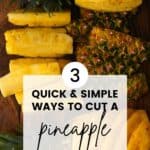
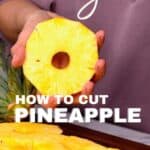


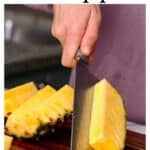

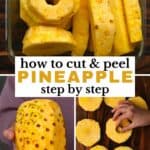












Have you tried or would you recommend not trying to put pineapple skin in a juicer?
Hey Ronald! I haven’t personally tested putting pineapple skin in a juicer, but I wouldn’t recommend it. The skin is quite tough and fibrous, which could strain or clog the juicer, depending on the type you’re using. If you want to extract flavor from the skins, a better option is to boil them to make pineapple tea or let them soak in water for a refreshing infusion.
If you do try juicing the skins, I’d love to hear how it goes!
Oohhhh this is so intriguing! Exactly what I was looking for!
You know it, Carla! 😉